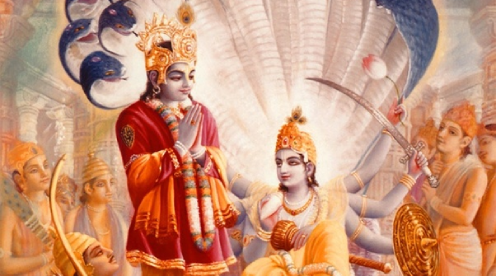THE COMMON MAN’S GITA
ananyas cintayanto mam
ye janah paryupasate
tesam nityabhiyuktanam
yoga-ksemam vahamy aham
Those devotees who are desirous of his conscious association, those devotees who meditate on him with extreme devotion, those devotees are assured of uniting their individual consciousness with the ultimate supreme consciousness.
Hari’s divine existence purifies the physical body and soul. Experiencing Hari’s divine manifestation is nectar. We evolve from the most sacred land of Bharathavarsha named after emperor Bharatha, the son of Shaakunthala. Bhaaratha is the birthplace of great avatars, powerful sages, warriors and good samaritans. Hinduism is the oldest religion in the world. It blends diversity of ideas on tradition, culture and spirituality. The Sanathana Dharma is a practise of life than just a religion. There are various preachers, authors and guides who taught philosophy in ancient India. Of them all, the Mahabharatha is considered the father of all epics as it not only preached philosophy and religion, it kindled civilization and preached the way of life.
Krishna Dvaipāyana completed the depiction of the great epic in his mind and approached sage Narada to pen it while he sang the verses. Under the thoughtful desire of sage Narada, lord Ganesha was invoked as the scribe, and thus the Bharaatha was rendered. Vedavyasa explained the rules of caste system, Upanishads, Vedas, and the wisdom of ancient Puranas, science of re-incarnation and yugas in the verses of the great epic.
Bhagavad-gita is the integral part of Mahabharatha. It is a narration in the Bhishmaparva. It covers 700 verses in 18 chapters.It is a divine dialogue between the supreme lord, Madhusudhana and Dhananjaya in the great battle of Kurukshetra. Hari incarnated on earth in 10 avatars to protect the good from the evil. The cycle of life-birth and death was well rendered in the avatars. The strength of Sri Hari was evident from the first avatar as a tiny fish (Matsya), to a boar delivering the mother earth from the clutches of evil, to a human with four limbs living in a civilized society amidst human beings. Every avatar explains the cycle of life denoting, the soul re-incarnates and is unperishable. The supreme avatar of Sri Hari in the Dwaparayuga as Madhusudhana highlights the wisdom of ancient Vedas and Upanishads and the ultimate connection of the mortal soul with the supreme consciousness.
The Gita is a revered conversation between the supreme avatar and the heart broken devotee who could not stand firm in a battle. It is the science of realisation of how a human soul can establish an eternal instinct and connection with the lord himself. The 18 chapters are compiled into three yogas denoting the different ways of spiritual realisation.
Karma yoga consists of the first six chapters. It highlights the attainment of consciousness through karma or one’s own deed. Bhakti yoga comprises of the next six chapters. It emphasizes that the ultimate consciousness is gained through bhakti or devotion to the lord. Jnana yoga consists of the last six chapters depicting the attainment of consciousness through jnana or intellect.
The sons of Pandu lived in exile for a period of 13 years and undercover for one year. After their exile they returned back to claim their kingdom from the Kaurava prince, son of blind king Dhritharashtra, Duryodhana. In a fit of fury, he refused to give them back the kingdom. Pandavas, the peace loving people sent lord Krishna to reason out with their cousin who refused to even give them the tip of the needle.This led to the great battle of Kurukshetra, between the cousins, Pandavas, led by Yudishtira and Kauravas led by the wretched prince Duryodhana. The battle between good and evil. The oldest brother, Yudishtira banked his hopes on the greatest archer Arjuna for the victory of the Pandavas.
When the war was about to begin, Arjuna suffered crisis of consciousness. Facing Bhishma, Drona and his cousins on the opposite field brought dejection in his inner self. The fear of losing his dear ones on the other side made Arjuna refuse to step into the battle field. At this moment, the supreme lord Krishna, uplifted Arjuna’s ignorance and ventured to prepare him physically and mentally for the battle. The science of realisation dawn on Arjuna after lord Krishna began preaching.
The voice of Devaki’s eighth son echoed: A duty is a responsibility and not a worry. Performing a deed to complete fulfilment is the ultimate goal rather than to worry about the fruits of benefits from it. The path of dharma decreases the sins committed and dominates the protection of good. The physical body is perishable but the soul within is immortal. The soul takes many more re- incarnations.
Lord Krishna, at this juncture explained the reasons for the incarnations or avatars he took. To restore peace and prosperity and cause destruction of evil, Sri Hari incarnated millennium after millennium for the establishment of dharma. The supreme lord explains the devotion to god can be in any form, a prayer, a thought of contentment, a flower or a leaf, if given with utmost devotion. Sacrifices and renunciation are important faces to reach the consciousness of the soul.
There are different kinds of devotees on this earth, one filled with light and goodness, another with evil and darkness, another with fire and passion. These qualities of human nature attribute to their kind of interaction with their daily activities. Life is a tree and the roots are men, liberation can be sought by crossing the ocean of the roots.
Sri Hari promised Dhananjaya that he would forgive all his sins and provide him refuge. Arjuna regained his crisis of consciousness and regained his nerve to fight the battle and restored the kingdom to his brother, Dharmaraja.
Gita is the only discourse delivered on the battle field. For many long years people are comforted with the sacred words of the lord supreme. It is not only a compilation of words but a key to unlock the mysteries of life. The Gita not only stressed on the preparation to a physical battle, but unfolded the mental and spiritual battles within. It is not just a book of philosophy, but a dictionary of knowledge to deal with the daily crisis and bring harmony and tranquillity.
Thus did the realisation dawn on Dhananjaya, the sense of duty and mind regeneration.
Gita transforms an individual from an unconscious form to a conscious living. The unconscious form makes the suffering innumerably severe pointing to the situation. As the unconscious mind doesn’t let the inner eye to open, miseries in life seem to never resolve. The Gita inculcates the use of appropriate intelligence to find solutions to daily crisis. Mind is an extremely beautiful instrument and shouldn’t be imprisoned with unconscious living.
The ultimate purpose of living is to increase awareness (Chaitanya).
I am a Doctor by profession. I have seen so many ailments and suffering. I have always pondered about why only a few people suffer mysterious deaths, why innocent just born babies die and why some are born with disease while others are free from any?
As I ventured into a book store, a small golden book caught my attention. Curiously enough I fetched the book and saw the cover which read Bhagavad-gita- handbook. I had an intuition to pick the book, even though I never had the passion to read spiritual books in my life. I put the book in my bag and forgot about it. As I searched my bag for money, I found this book, which interested me to read through the lines. As I started the very first page, I felt a sign of positive vibe which made me continue reading it. It made me ponder about so many decision making situations I had erred because of my unconsciousness trying to burden the fault on the situation. There were so many answers to my questions. As I came to the end of the book, I understood that the answers were already there and I was searching for it thinking they were hidden quests. The battle wasn’t physical alone but was a mental one. Lord Krishna prepared his devotee not only for a physical battle but also for a mental harmony. The intellect that was deprived by anxiousness and emotional attributes were now no doubt a deed/duty to be performed and not to expect. I learnt to do my deeds without expectation. I started devoting more time to learn spiritual sciences and god to change my lifestyle, to help people around me. I am more happier than before. Life never ended for me everyday without a battle. I loved to face my war because it helped establish a connection between me and the divine. The many questions about life and death and the miseries suffered by a few was due to the soul’s misfortune. When the supreme knew to give the suffering he also knew how to end it. It was to be left to the nature, just like how a damaged automobile can be replaced, the physical body could be replaced once it perished, but the soul saw no death. Gita was the basic foundation for my understanding of deed, bhakti and intellect. I am still in search of many more questions I still wonder about. May be it will take more time to learn than I expect. The small book that changed my perspective about life, its fortunes and misfortunes still stays with me wherever I go. My unconditional love for lord Krishna, moved me to write this. I thank him for, He nurtured me, protected me and given me a stand in the world.




